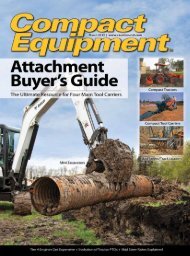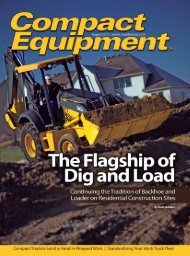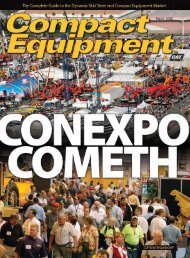CE EQUIPMENT CONNECTION - Compact Equipment
CE EQUIPMENT CONNECTION - Compact Equipment
CE EQUIPMENT CONNECTION - Compact Equipment
Create successful ePaper yourself
Turn your PDF publications into a flip-book with our unique Google optimized e-Paper software.
Check the Flow<br />
Skid steer loaders often are the go-to earthmover for<br />
landscape, agriculture and construction projects thanks to<br />
their small size and versatility with work tools. Buyers have<br />
a wide range of choices when it comes to manufacturers and<br />
models — even when it comes to hydraulics. Manufacturers<br />
offer high-fl ow and standard-fl ow machines, usually in a<br />
variety of sizes for each confi guration.<br />
1. How It Works — A diesel engine and a set of hydraulic<br />
pumps (drive and implement/auxiliary) comprise a skid<br />
steer loader’s power train. Hydraulic pumps are connected<br />
to the engine; variable displacement pumps provide power<br />
to the hydraulic drive motors and fi xed displacement<br />
pumps provide power to the loader arms, move hydraulic<br />
fl uid through fi lters and provide pressure to run the pilot<br />
controls. Engine speed will determine the amount of<br />
power the system can generate.<br />
2. Hydraulic Ground Drive — When an operator is not running<br />
a work tool, the drive pumps can direct full power<br />
to the wheels or tracks. A lot of power is needed to propel<br />
the machine into a dirt pile and break the load out, but if<br />
the implement pumps were to supply pressure and fl ow<br />
for this operation while the drive pumps were still drawing<br />
max power, the engine could stall. To combat this, some<br />
machines automatically reduce the displacement of the<br />
pumps preventing the engine from stalling while maintaining<br />
torque to the wheels or tracks at a reduced speed,<br />
providing maximum power to the<br />
implement circuit.<br />
3. Gear and Piston Pumps — When<br />
selecting a machine, contractors<br />
should consider the type of<br />
pump the high-fl ow system is using.<br />
Most high-fl ow systems are<br />
designed by adding a gear pump<br />
to the standard fl ow circuit to<br />
add incremental fl ow at the same<br />
system pressure as the standard<br />
system. This increases the available<br />
hydraulic horsepower by<br />
increasing the speed of the work<br />
tool, but it does not provide additional<br />
torque to the work tool.<br />
Additional torque would require<br />
the high-fl ow system to provide<br />
higher system pressure too. Variable<br />
displacement piston pump<br />
high-fl ow systems are currently<br />
the only such systems that provide<br />
higher system pressure.<br />
4. High and Standard Flow — Each<br />
manufacturer may have different<br />
criteria for “high fl ow” or “standard<br />
fl ow” among their own machines.<br />
A machine with a highfl<br />
ow circuit typically exceeds 26<br />
gpm and 3,300 psi. The typical<br />
fl ow for a standard-fl ow machine<br />
is 22 gpm.<br />
By Keith Gribbins, Managing Editor of <strong>Compact</strong> <strong>Equipment</strong><br />
5. Keeping Things Cool — When considering a machine with<br />
high fl ow, it is important to take the cooling capability<br />
of the machine’s hydraulic system into account. Because<br />
high-fl ow machines generate more hydraulic horsepower<br />
they can also generate signifi cantly more heat in the<br />
hydraulic system. Gear pump high-fl ow systems generally<br />
will produce more heat than a variable displacement load<br />
sensing pump system. This is due to the gear pump system<br />
utilizing a relief valve to manage pressure in the auxiliary<br />
circuit.<br />
6. Know Your Tool’s Flow Needs — Generally, a machine with<br />
high-fl ow hydraulics is able to operate work tools designed<br />
for standard-fl ow hydraulic machines, but the reverse<br />
pairing (high-fl ow tools with a standard machine) is not<br />
recommended. The hydraulic system of the standard-fl ow<br />
machine will be unable to supply the fl ow needed to properly<br />
operate the work tool.<br />
7. Rent to Own — For contractors who work most often<br />
in medium-duty applications, owning a standard-fl ow<br />
machine and work tools and renting a high-fl ow machine<br />
for the occasional heavy-duty projects may prove the best<br />
solution. Contractors may also consider renting both<br />
types of machines in order to test their capabilities on real<br />
jobsite conditions.<br />
Hydraulic hose hookups and fi ttings are matched to the machine, ensuring a proper match and<br />
tight fi t eliminating the chance of leaking and loss of pressure. A manufacturer designs the<br />
machine controls to work with specifi c corresponding tools as a system and the pairing is<br />
intended to maximize the performance and controllability of the work tool.<br />
compactequip.com January 2008 <strong>Compact</strong> <strong>Equipment</strong> 19








